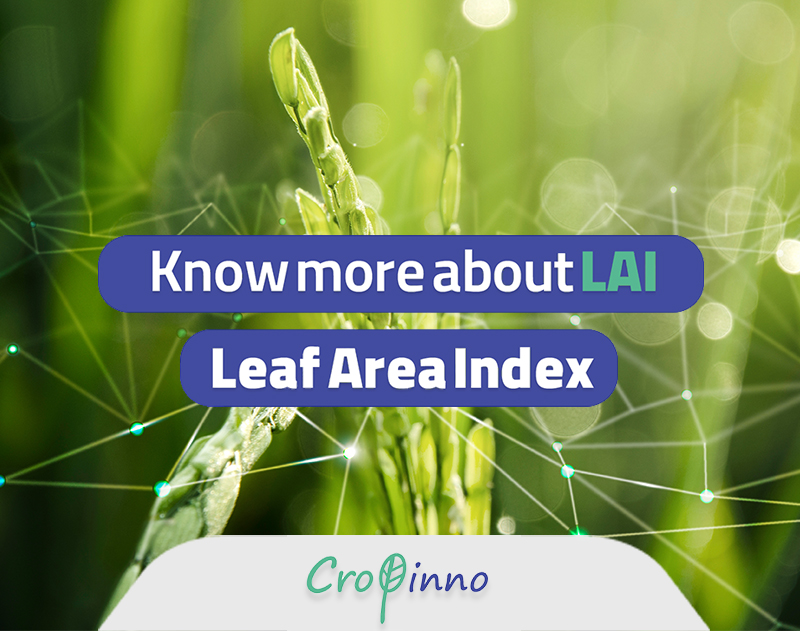Many factors help determine the health and productivity of agriculture crops, one of them is the Leaf Area Index or LAI. the ratio of the area covered with the leaves of a plant or tree to the area of its subsurface determines the amount of this index. Leaf Area is a key variable used for physiological studies of plant growth, light absorption, photosynthetic efficiency of evapotranspiration, estimation of plant growth, plant yield, response to fertilizers and irrigation. Measuring leaf area index plays an important role in measuring the impact of environmental stresses such as drought in the algorithms presented through remote sensing and modeling.
For some crops, such as tea and tobacco, where the leaf is the most important (economic) product, LAI is a direct and good indicator of crop performance.
There are many methods for measuring leaf area, including indirect methods that estimate the area of individual leaves with their linear dimensions such as leaf length and leaf width. The definition of leaf area index is determined by the method of measuring it. The availability of spatial and temporal information from LAI is also crucial for climate change studies.
Leaf Area Effect
In general, in field studies, to evaluate the fertility and productivity from biogeochemical cycles, it is necessary to measure the quantity and amount of canopy cover. The leaf area indicates the potential of the existing leaf area for gas exchange with the atmosphere and biosphere. Plants with more vertical leaves have more leaf area, and the higher the leaf area index, the higher the light saturation level of a plant community. Plants that have a higher leaf area, being more parallel to the horizon, absorb more rain and prevent runoff and soil erosion. They also provide an opportunity for rain to penetrate deep into the soil by interrupting the rain landing on the soil surface. In many areas with low rainfall, there is no permanent vegetation in the pastures due to insufficient moisture and the soil does not have sufficient carbon storage. For this reason, the study of leaf index in rangelands can indicate the quality and quantity of fertility of an area.
LAI & Crop Yield, Are they connected?
Photosynthesis is the process of converting light energy into chemical energy. We know that photosynthesis is directly related to increase/decrease in performance. It occurs mainly in the green leaves of any plants, yet another reason for the leaves to be so important. So, we need to measure the area of the leaves to find out what is going on inside a plant.
Retrieving Leaf Area Index (LAI) Using Remote Sensing
Leaf area index is one of the main biophysical and biochemical parameters to study in farms.
Measuring this plant index is a good way to study the condition of fields and the plant’s response to environmental stress. Measuring a parameter directly is costly and difficult and requires laboratory devices and equipment, that’s why nowadays we use remote sensing as a much more efficient & accurate method in estimating these two parameter categories. In Remote sensing systems such as Cropinno, LAI information is retrieved from satellites for each selected field and its data is modeled and implemented using artificial intelligence to recover leaf area changes with the necessary precision.

Plant moisture
Over time, the increase in population and the need for food resources will lead to the development of industry and the need to increase the level of health. Therefore, the pattern of water consumption will change a lot in the future. Water consumption management in the agricultural sector increases efficiency in this field and helps to save more water. To improve water consumption management in agriculture, we must accurately estimate the amount of water consumption. Overestimating the water required by the plant, while wasting irrigation water, creates marshes and causes leaching of soil nutrients and contamination of groundwater resources. At the same time, underestimating the required irrigation will cause uncontrolled moisture stress to the plant and as a result will reduce the yield.
Measuring the amount of water inside the canopy, which is the amount of water per unit of land, can be very effective in determining the total amount of water used in farms. In the Cropinno system, artificial intelligence and modeling of special algorithms is used to estimate the plant moisture level in the most efficient way. In simpler language, it shows which part of the farm is suffering from water shortage or drought stress.
The water content inside the canopy (CWC) is obtained by using the ratio of the amount of water inside the leaf area (EWT) in the leaf area index.
- CWC = LAI * EWT
It can be said that the water content of the canopy indicates the difference between the fresh weight and the dry weight of the plant.
- CWC = FW-DW
- FW = Fresh weight
- DW = Dry weight
Use of artificial intelligence in product water management
One of the tools for studying and improving various aspects of water management is modeling plant growth under stress conditions to better understand different plant processes and their contribution to crop yield. Models show how plants respond to environmental conditions. These models are used to understand the response of crops to the dynamics of soil and atmospheric systems to help better management & make better use of available resources.
Cropinno provides AI-calculated algorithms related to plant access to water resources which can be used by farmers to be able to make better use of limited water resources.


